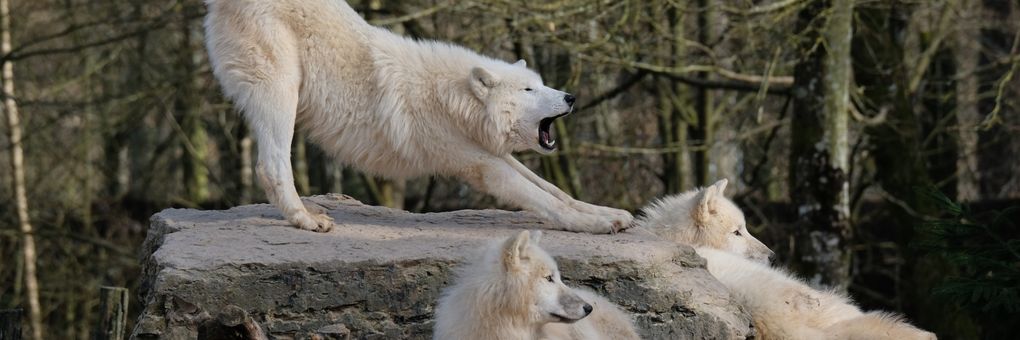The strikingly handsome Arctic wolf, a close relative of the much more numerous and widespread grey wolf, dominates its natural habitat above the timberline in the Arctic Circle, encompassing parts of northern Canada and Alaska, as well as Greenland. Only the polar bear challenges it for dominance of the Arctic food chain. However, due to global warming, there are new challenges – hunting ground is shrinking, and there is a crisis affecting the numbers of animals they prey upon for vital food resources.
◊
In the far north, where there are virtually no indigenous human settlements, lies the Arctic Circle where not even the hardiest trees can survive. But in this forbidding environment of tundra, permafrost, snow, and ice is, almost unbelievably, a wealth of wildlife – land-dwelling, sea-dwelling, and amphibious. And at the top of the food-chain stand two species: the polar bear and the Arctic wolf (Canis lupus arctos).
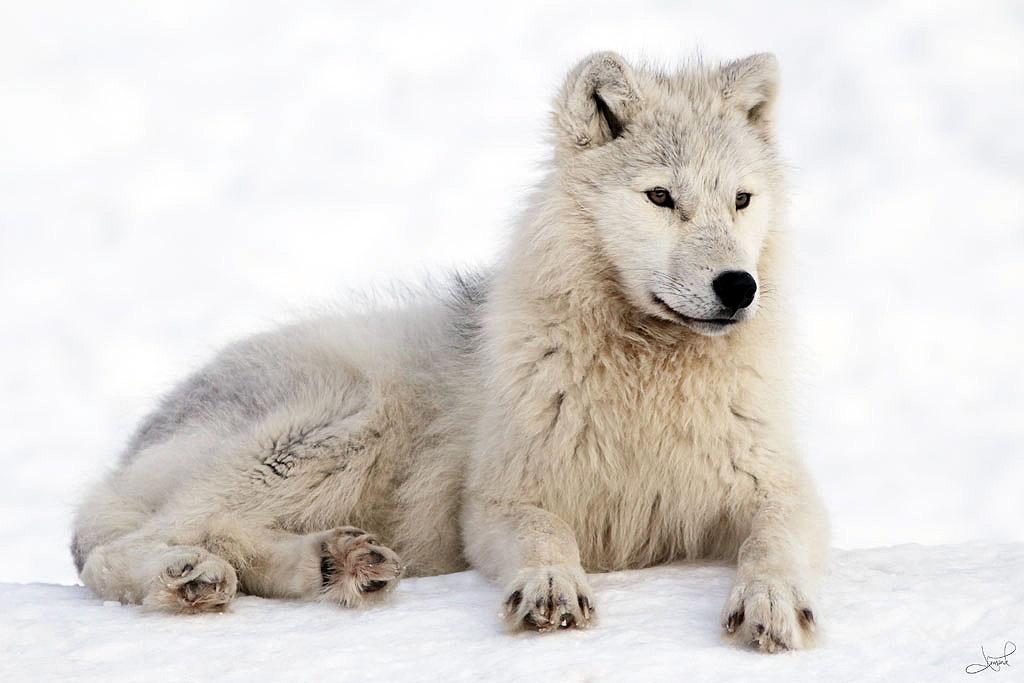
Arctic wolf in Montobello, Quebec, Canada (Source: Wikimedia Commons)
The two species rarely interact: Polar bears feed on seafood almost exclusively, while Arctic wolves primarily hunt land-based creatures. Only rarely – and likely due to climate-induced stress such as loss of habitat – does a wolfpack target bears, and then only vulnerable bear cubs.
Arctic wolves live, prey, and reproduce in an inhospitable region, a generally white-blanketed rocky terrain for which this species is uniquely well-suited. You could say that natural selection produced a type of wolf that could thrive specifically because of the threats and harshness of their natural surroundings. But what are the adaptations that have allowed the Arctic wolf to survive on the tundra of the polar north?
Accommodations that Allow a Species to Survive
Limiting heat loss by retaining life-essential warmth is a key facet of the Arctic wolf’s environmental adaptation. First off, Arctic wolves are built closer to the ground, with legs that are shorter, squatter, and more thickly furred than their nearest relative, the grey wolf. These characteristics offer singular advantages to keep Arctic wolves warmer in brutally cold winter conditions. In addition, they have two distinct layers of fur: a dense, water-resistant layer of short, thick fur, and a longer, finer layer that protects the inner layer from cold-inducing moisture and thickens in wintertime.
Fur extends to the wolves’ paws, insulating the spaces between their claws and assisting their grip on icy ground. A thin layer of fur also helps insulate their ears from the bitter cold. The Arctic wolf’s ears are also smaller than those of the grey wolf, and its muzzle is shorter than other wolf species. These adaptations optimize the wolf’s ability to limit heat loss and to keep its ears, and the amount of space exposed to chill winds, as small and closed as possible while not muffling the ability to hear.
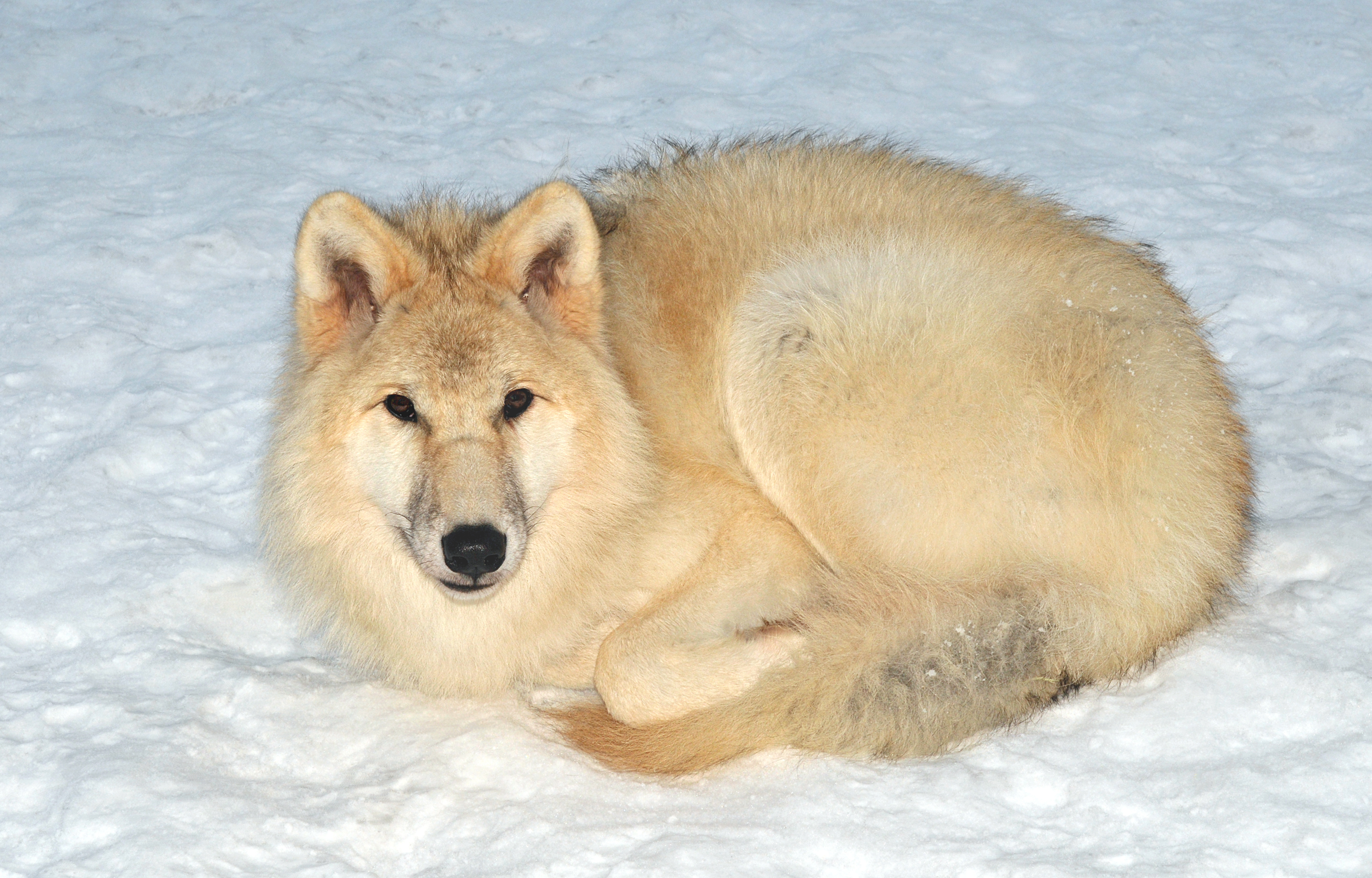
Arctic wolf near Springe, Hanover, Germany (Credit: Michael Gabler, via Wikimedia Commons)
In fact, not only is the Arctic wolf’s hearing ability enhanced compared with other wolf species, their senses of sight and smell are heightened as well. These advantages make the wolf an excellent pack hunter in extreme circumstances, able to support its pack family.
Further, underneath the wolves’ skin lies a layer of body fat, more prominent and denser than that of their grey wolf relatives. This thick layer of fat allows Arctic wolves to eat less frequently, a strategic advantage in the rough, cold climate. Significantly, their paws maintain a lower temperature than the rest of their body, which minimizes heat loss through the paws’ constant contact with frozen ground.
If you’d like to see the real-life drama of Arctic wolves in action, watch MagellanTV's Top Cats.
Another factor in the Arctic wolves’ adaptation is their very large hunting territory. Each wolfpack controls territory of up to 1,000 square miles, which enables the pack access to greater food resources in relatively barren surroundings without impinging on the territories of other wolves. (Later we’ll explore how this advantage is turning into a liability in the changing climate.)
Make no mistake, though: It’s a hard life in which the Arctic wolf finds itself. Compared with grey wolves that live in relatively milder climates, Arctic wolves give birth to fewer cubs per season than other wolves – two or three is the average litter size, as opposed to five or six for other breeds. And staying alive to maturity is a relentless struggle. More than half of all Arctic wolves die in the first year of life, primarily (as we’ll see further below) from too little food as a result of a lack of appropriate prey brought on by a breakdown in the food chain.
Pack Behavior in Arctic Wolves
Pack behavior is essential to the survival and dominance of the Arctic wolves. Each pack is dominated by an alpha male, along with its mate, the beta female, and perhaps several generations of offspring. Membership in a pack is not often a lifetime arrangement. Pups are taken care of by their mother and join in hunting expeditions as early as two months of age. However, when the offspring reach the age of approximately two years, they generally separate from their pack to find a mate and new grazing land, and to start their own pack.
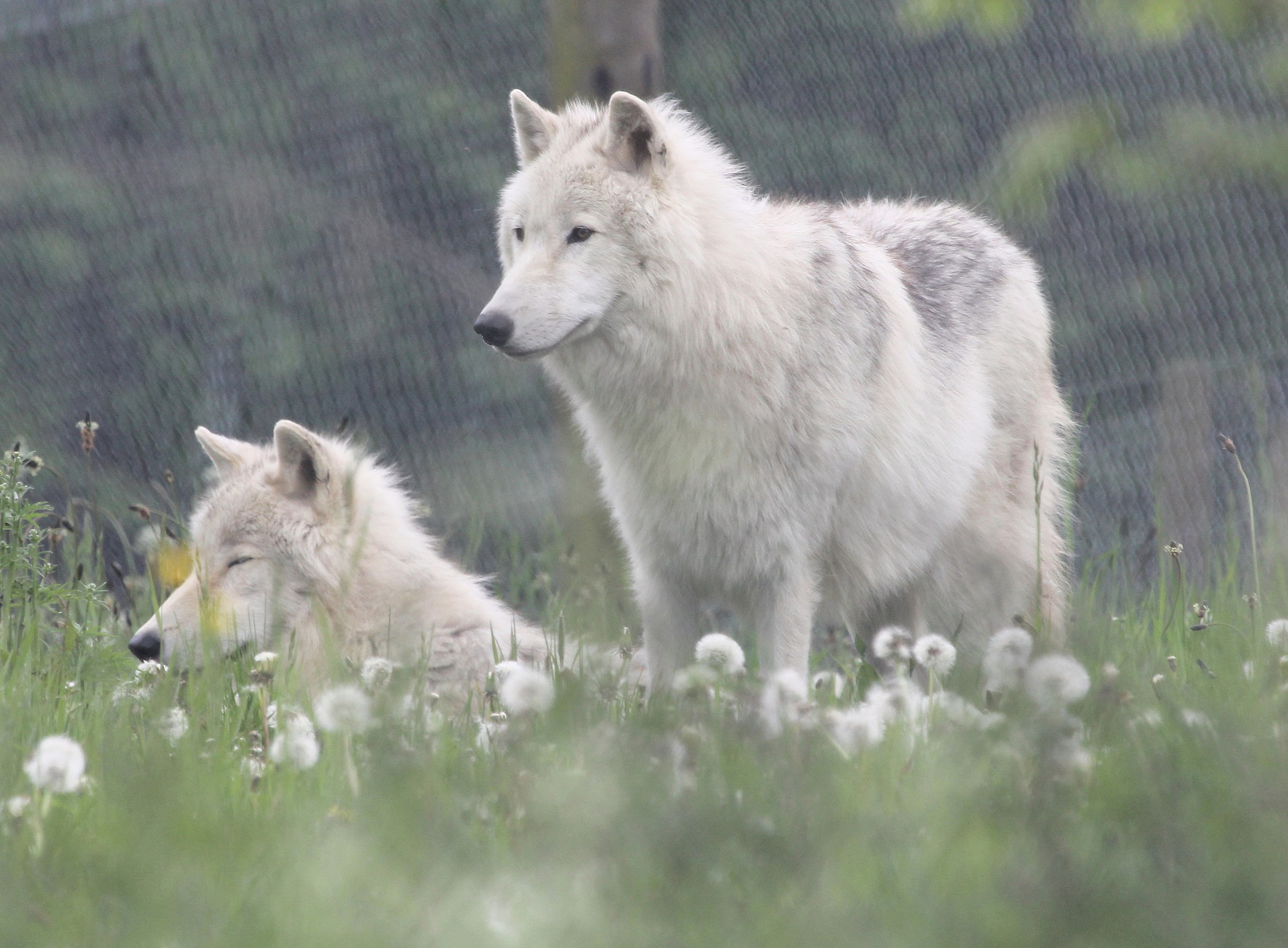
Arctic wolves in spring (Credit: Mark Kent, via Wikimedia Commons)
Arctic wolves rarely stray too far from other pack members, enhancing their ability to hunt strategically, encircling and trapping prey. Though these wolves do sometimes hunt solo, a lone wolf would have little advantage in taking on the Arctic-dwelling musk ox, a staple of the wolves’ diet that towers over wolves and congregates in herds.
But in their wolfpacks, which generally have between five and eight members (though packs of up to 20 are not unknown), the wolves, with their greater speed and maneuverability in the ice and snow, can manipulate a herd of oxen, separate one, and make a meal of it that can potentially serve the wolfpack for up to a week.
What Do Arctic Wolves Target for Food?
In addition to the musk ox, which can reach up to eight feet in height, Arctic wolves’ other primary prey is the Arctic hare, or “snow bunnies” that burrow and build warrens under snow cover. They are historically plentiful, as are the wolf’s other secondary sources of meat. These include moose, caribou, lemmings, nesting birds, various smaller animals, and even seals.
Arctic wolves have a cruising speed while hunting of 5 mph, which they can maintain for a solid eight to 10 hours a day. This heat-preserving pace can easily accelerate when need be, to a top sprint of about 40 mph over short periods of time.
Arctic wolves are considered the apex predator for the regions they inhabit; this means that they are not targeted as prey by any other creature they would naturally encounter. And since they rarely come in contact with humans in their roaming territory, they are not hunted to the extent that other species of wolves are.
You might think that, absent direct human intervention and threats from other predators in their lifecycle, Arctic wolves would be thriving, with no threat to their continued existence. And to a great extent you would not be wrong. In fact, no less an authority than the World Wildlife Federation classifies the Arctic wolf as having a status of “least concern.”
But this does not mean there is no danger at all. Humans may not have permanent settlements that encroach on the Arctic wolves’ territory, but human activity affects them nonetheless.
Staying Alive: Factors that Impinge on the Wolves’ Survival
Arctic wolves who manage to make it beyond their first year are generally able to live seven to 10 years in the wild; of all wolf breeds, they are the least threatened by humans. But there is a real threat to their strength and survival, and it comes from climate change in the Arctic. This is a complex process, and it highlights the intricate interdependency of all life on the natural environment. It’s as if you were to pull at one thread in a densely woven fabric, and the entire pattern started to disintegrate.
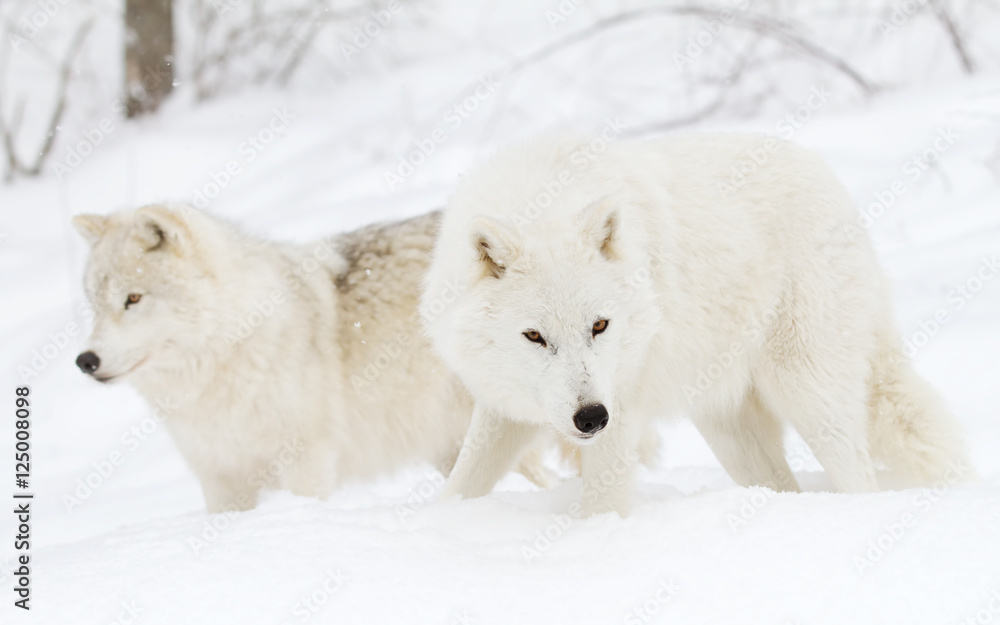
Wolves’ traditional food supply has been reduced, leading to lower sizes of broods and lifespans of adults. Habitat destruction is primarily due to climate change and the resulting separation of islands in the far north due to melting ice, with more than 2 million sq. km. (1.25 million sq. mi.) of midwinter sea ice having disappeared from the Arctic over the past 40 years. Extreme weather variations have caused disruptions in the food chain, too. Arctic wolves’ main prey, musk ox and Arctic hare, face daunting challenges in finding food, so their numbers have declined.
There is also some man-made habitat destruction due to industrial development: mines, roads, and pipelines interrupt food supply and hunting areas.
The already scarce habitat, and its gradual diminution caused by melting sea ice, is taking a toll on the long-term health of the Arctic wolfpack. While wolves in the wild usually die from old age or from injuries received while hunting or fighting with other wolves, Arctic wolves face the additional threat of food scarcity.
Humans Are Still the Greatest Threat: Disruptions in the Wolves’ Food Chain
The Arctic food chain relies on a stable sea ice platform – sea ice links the habitat of wolves from island to island to ensure adequate access to prey. Losing those links between land masses isolates wolf packs, restraining them from their prey, as well as limiting their encounters with wolves from other wolf packs. This lessens their ability to interbreed, threatening genetic diversity and well-being.
It’s not that Arctic wolves are helpless. As we have seen above, they are well-adapted to finding food in the seemingly barren wastelands they inhabit. They are opportunistic hunters – and collectors. They will eat almost anything if need be, including garbage and carrion.
But common prey are gradually losing ground in their natural habitat. Take the caribou, for one example. Caribou are losing access to food because ground cover is now more icy than snowy. Warmer weather, with snow melting and refreezing as ice, hardens the surface on which this type of deer forages, limiting their ability to dig beneath the ground cover to access plants and lichen under the snow.

(Credit: RoyalCathayan, via Wikimedia Commons)
Additionally, the bloom-dates for plants in the Arctic are now earlier in spring than formerly, and caribou have not yet adapted to this seasonal change; they are looking for life-sustaining plants after the blooms have subsided. As a result, fewer caribou calves are born, and thus there are fewer on which wolves can feed.
Seals are suffering a similar fate. A recent article in the Guardian newspaper highlights the fragile, threatened link from the smallest of Arctic-dwelling creatures to the largest. The loss of sea ice due to climate change is decimating algae that collect on the bottom of chunks of floating ice in the Arctic ocean. The dearth of algae robs larger zooplankton of their food source, so their numbers are shrinking. The lack of zooplankton causes fish to disappear, since fish need these plankton for survival – and, hence, there are fewer fish for seals to feed on. Seals, which are prey both of polar bears and Arctic wolves, are suffering declining numbers as well.
How Will the Wolf Survive?
Despite its adaptation to its traditional habitat, the Arctic wolf faces a threat to its long-term chances of survival as an indirect consequence of human behavior; specifically, the loss of sea ice that is diminishing its access to food and other wolves. While they are less threatened than other species of wolves that have more interaction with humans, the threat they face is real and not insignificant.
Though we have little occasion to interact with these magnificent creatures, we should understand their place in the chain of life and take the threats they face seriously. After all, we are likely to face the same damaging processes in the natural environment that they do – and they’re coming closer and sooner than you might imagine. But for now, let’s enjoy observing them and their natural habitats through thrilling and beautifully shot documentaries. Someday these films may be all we have to preserve the memory of the great Arctic wolf.
Ω
Kevin Martin is Senior Writer for MagellanTV. He writes on a wide variety of topics, including outer space, the fine arts, and modern history. He has had a long career as a journalist and communications specialist with both nonprofit and for-profit organizations. He resides in Glendale, California.
Title image: Arctic wolves (Canis lupus arctos) at Sainte-Croix animal park by Musicaline via Wikimedia Commons.

